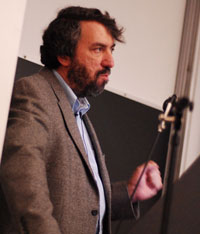NIH Award from the National Institute of Neurological Disorders and Stroke
Structural Heterogeneity and Covalent Changes in Beta Amyloid Fibrils
- Principal Investigator: Stephen Meredith, MD, PhD, Professor of Pathology, Biochemistry and Molecular Biology, and the College
- Start Date: September 30, 2009
- Total Award Amount: $353,194 (first year); $339,163 (second year)
Public Health Relevance
l3-amyloid causes Alzheimer's Disease, but its fibril structure remains unknown. Using AD brain amyloid, and mutant AI3, we will determine brain fibril structure by SS-NMR.
Project Description
The ultimate goal of this project is to understand the components of fibrillogenesis pathway structurally, focusing on [3-amyloid (A[3) of Alzheimer's Disease (AD), The specific aims of this proposal are as follows: 1, To examine, by solid-state NMR, AfJl-40 fibrils seeded by brain amyloid from patients who died with Alzheimer's Disease, i,e" fibrils seeded by ex mortuo brain amyloid, A[31-40 can adopt more than one stable conformation in fibrils, and these conformations can be passed on to progeny fibrils, But which of the known conformations, if any, is adopted by A[31-40 in the brains of patients with AD? To address this question, we purified brain amyloid from AD patients, and used this material to seed fibril formation by labeled synthetic A[31-40, Exciting new data, recently published (PNAS 106:7443, 2009), indicate that brainseeded fibrils have a novel structure, distinct from either of the known A[31-40 fibril structures,
To address the question of fibril heterogeneity and disease phenotype, we will also compare ex mortuo seeded fibrils formed using material from different anatomic locations of the brain, and from different patients, 2, To examine mutations of the AfJ peptide occurring adjacent to the "bend region", Of the point mutations (associated with familial AD) within the A[3 sequence itself, most are at positions 21-23, adjacent to the bend region that is essential for association of the two [3-sheets of wild-type A[3 in fibrils, We have now shown by solid-state NMR and other data (Tycko et aI., Biochemistry 48: 6072, 2009) that fibrils of the Iowa mutant, D23N-A[3 have an unprecedented structure for full length AI3 fibrils, antiparallel l3-sheets, In addition, new data on the Japanese mutation, L\E22-Af3 indicate that, contrary to published reports, it readily and abundantly makes j3-sheet fibrils, and new solid-state NMR data (unpublished) show that these, too, deviate from the structure of wild type Aj3 fibrils.
In the revised proposal, we focus on these two exemplary mutant forms of Aj3, which have in common the loss of an anionic residue and very rapid fibril formation, though there are instructive differences as well. For this aim, we will: A) Examine the C-terminall3-sheet region of D23N-AI3 (not previous studied, but currently in progress); 8) Examine both the N- and C-terminall3 sheet regions of ~E22-Aj3 (already in progress). C) We have recently shown that fibrils of both of these mutant peptides can cross-seed wild-type AI3. Accordingly, we will examine wild type A131-40 fibrils made by cross-seeding, using D23N-AI3 and ~E22-AI3 fibrils as seeds. In all of these cases, results will be compared with data obtained previously and new data on brain-seeded AI3 fibrils to determine whether the wild type peptide is also capable of adopting structural forms similar to those of the mutant peptides. The materials for these studies are already in place (e.g., brains from individuals dying with AD and controls), and new, streamlined methods of solid-state NMR make this project entirely feasible in the two year time frame.
This award is funded under the American Recovery and Reinvestment Act of 2009, NIH Award number: 2R01NS042852-06A2

Stephen Meredith, MD, PhD,
Professor of Pathology, Biochemistry and Molecular Biology, and the College
